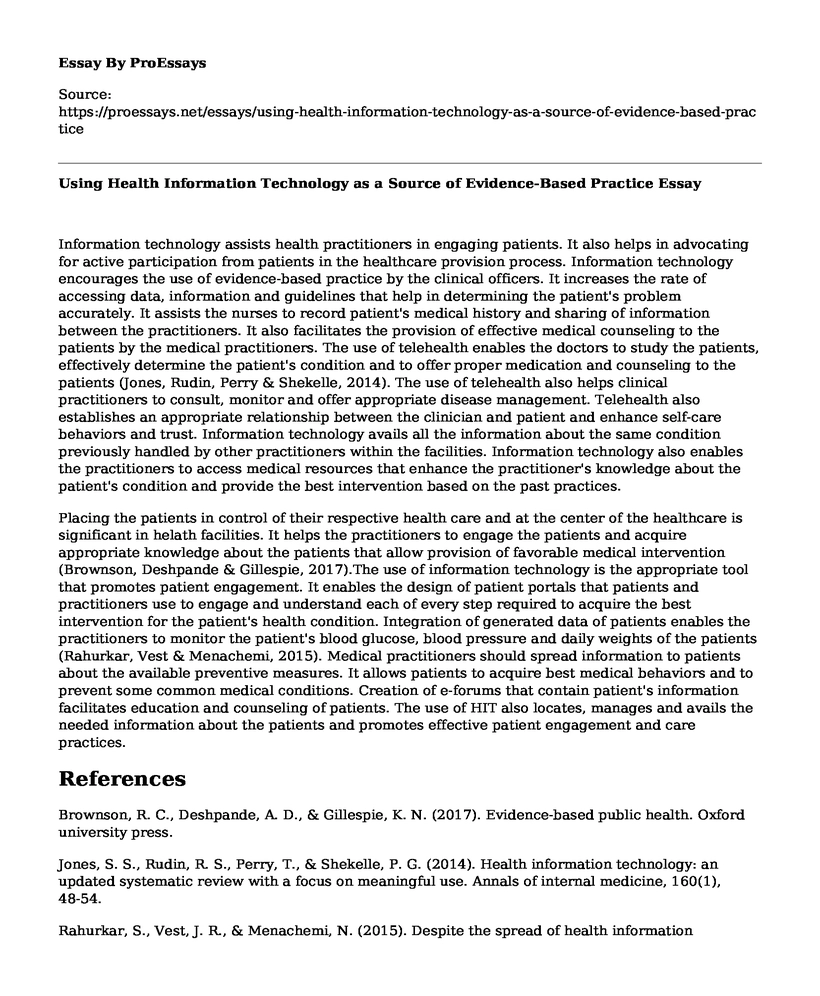Information technology assists health practitioners in engaging patients. It also helps in advocating for active participation from patients in the healthcare provision process. Information technology encourages the use of evidence-based practice by the clinical officers. It increases the rate of accessing data, information and guidelines that help in determining the patient's problem accurately. It assists the nurses to record patient's medical history and sharing of information between the practitioners. It also facilitates the provision of effective medical counseling to the patients by the medical practitioners. The use of telehealth enables the doctors to study the patients, effectively determine the patient's condition and to offer proper medication and counseling to the patients (Jones, Rudin, Perry & Shekelle, 2014). The use of telehealth also helps clinical practitioners to consult, monitor and offer appropriate disease management. Telehealth also establishes an appropriate relationship between the clinician and patient and enhance self-care behaviors and trust. Information technology avails all the information about the same condition previously handled by other practitioners within the facilities. Information technology also enables the practitioners to access medical resources that enhance the practitioner's knowledge about the patient's condition and provide the best intervention based on the past practices.
Placing the patients in control of their respective health care and at the center of the healthcare is significant in helath facilities. It helps the practitioners to engage the patients and acquire appropriate knowledge about the patients that allow provision of favorable medical intervention (Brownson, Deshpande & Gillespie, 2017).The use of information technology is the appropriate tool that promotes patient engagement. It enables the design of patient portals that patients and practitioners use to engage and understand each of every step required to acquire the best intervention for the patient's health condition. Integration of generated data of patients enables the practitioners to monitor the patient's blood glucose, blood pressure and daily weights of the patients (Rahurkar, Vest & Menachemi, 2015). Medical practitioners should spread information to patients about the available preventive measures. It allows patients to acquire best medical behaviors and to prevent some common medical conditions. Creation of e-forums that contain patient's information facilitates education and counseling of patients. The use of HIT also locates, manages and avails the needed information about the patients and promotes effective patient engagement and care practices.
References
Brownson, R. C., Deshpande, A. D., & Gillespie, K. N. (2017). Evidence-based public health. Oxford university press.
Jones, S. S., Rudin, R. S., Perry, T., & Shekelle, P. G. (2014). Health information technology: an updated systematic review with a focus on meaningful use. Annals of internal medicine, 160(1), 48-54.
Rahurkar, S., Vest, J. R., & Menachemi, N. (2015). Despite the spread of health information exchange, there is little evidence of its impact on cost, use, and quality of care. Health Affairs, 34(3), 477-483.
Cite this page
Using Health Information Technology as a Source of Evidence-Based Practice. (2022, May 09). Retrieved from https://proessays.net/essays/using-health-information-technology-as-a-source-of-evidence-based-practice
If you are the original author of this essay and no longer wish to have it published on the ProEssays website, please click below to request its removal:
- The Challenges Experienced in Healthcare Institutions
- Should Adderall Be Used as a Performance Enhancing Drug for College Students?
- Research Paper on Prosthodontics Profession
- Improved Discernment & Decision Making: My Rotations - Essay Sample
- Essay Example on Data Center Risks: Identifying & Mitigating Negative Effects
- Paper on Shadow Health Clinic: 24/7 Digital Clinical Experience for Patients
- Free Essay Example on Policy Background







